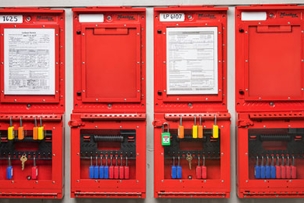Fall protection equipment maintenance and inspection is an essential part of safety when working at height. Workers need to follow these simple steps as part of the routine to ensure that harnesses and lanyards offer optimal protection:
- All harnesses and lanyards must be inspected before use. Users need to check and ensure that all labels, harness serial numbers, inspection and withdrawal dates are legible. It is also important to check that the safety standard certification mark is visible.
- Inspect the harness and lanyard webbing for any cuts, tears, holes, excessive stretching or abrasion damage. Depending on the type of industry, harnesses can be exposed to heat, corrosives and even hardware, which can compromise the integrity of the webbing.
- Examine all the harness and lanyard hardware and check for corrosion, deformation or excessive movement. Buckle adjusters, D-rings, and Snap Hooks should be free from dirt and damage. If any of the hardware exhibits excessive wear and tear – replace it immediately.
- Ropes should be checked for cuts, abrasion or fraying, as well as cracked or broken thimbles. If damage to the rope is visible, remove the rope from service and document.
- Check all the sewing on the harness and lanyard to ensure that there are no broken, cut or worn threads. It is also important to look out for any damaged or weakened threads as a result of damage through exposure or deterioration. If there are any visible unauthorized repairs, remove the equipment from service immediately.
Basic care of the safety equipment will not only prolong its durable life, but will also contribute towards the performance of its vital safety functions. Proper storage and maintenance after use are just as important as cleaning the equipment of dirt, corrosives and contaminants.



Talk to Us!
It makes sense that you should examine all the harnesses and hardware to ensure that everything is in the best shape possible. Doing this will ensure that your workers stay safe while they are doing their jobs. If you were to hire a professional to do the safety equipment inspection you could probably safe some time as well because you won't have to do it yourself.
https://www.forceengineering.com.au/inspections-and-testings
21I am glad that it is a rule to check all harnesses and lanyards before allowing someone to use them. I thin working with extreme heights is a dangerous job. One slip and you're gone so I am grateful that they have to take the precautions to check their equipment before each use.
https://www.iwrlifting.com.au/products
24Leave a reply
Your email address will not be published. Required fields are marked *